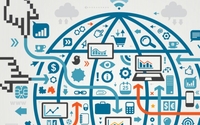Commentary
Where Marketing Fits in the World of Smart Everything
- by Chuck Martin , Staff Writer, October 28, 2015

In addition to everything becoming connected in the Internet of Things, a number of things are being named or classified as smart.
We have smart watches, smart cars, smart thermostats as well as connected objects that reside in smart homes. And then there are smart buildings that will reside in smart cities.
Some of the marketing implications of the smaller smart things are somewhat straightforward to predict or at least speculate, since many of the items have some of the same characteristics as non-smart objects today.
For example, smart watches and other wearables have screens on which messaging can be sent. While the content and form of some of the messaging is evolving, it still will comprise data in one form or another transmitted to a screen.
Other in-home, connected objects also can have screens used to send commands, which means the screens can be used for other things
But it strikes me that the larger the smart entity, the tougher it may be to incorporate marketing messaging.
For example, a smart building typically would comprise elements for managing internal systems, such as lighting, heating and self-diagnosing maintenance. Many of those IoT features would be behind-the-scenes functions and, in many cases, totally automated.
And even bigger in scope would be smart cities.
Yesterday I sat down with Michael Dixon, general manager smarter cities at IBM, to discuss what some of the potential implications of smart cities might be for marketing and consumer messaging down the road. Dixon was in Las Vegas for the IBM Insight conference, where all things data related were discussed.
Dixon sees the coming transformation of cities into smart cities being driven by pressure on cities to improve their return on assets, adding capacity, massive disruption and a shift to users paying for more things.
He also acknowledges that while the technology may be available to make cities smart, the people needed to make it occur are not always as ready.
“The technology is complex and difficult but it is not what’s slowing progress,” Dixon said. “Organizations and politics and culture are stopping it. The business cases are dramatic and not incremental projects.”
From a marketing perspective, the opportunity may likely come after making cities smart gets well under way.
For example, multi-purpose vehicles, autonomous or semi-autonomous vehicles will change how people commute.
“The time spent commuting is going to come down,” said Dixon.
What this potentially means for marketing and advertising is that consumers will have more spare time.
The future marketing opportunities could involve creating new and novel ways to occupy that spare time.
This is not happening in a big way this year or next, but it is around the IoT corner.
Meanwhile, there still are smart watches, smart thermostats and smart cars for marketers to tackle in smart ways.



